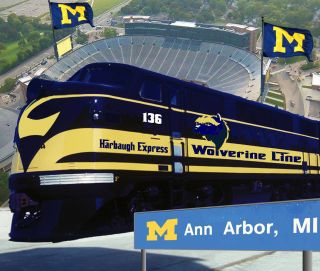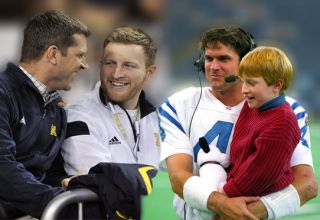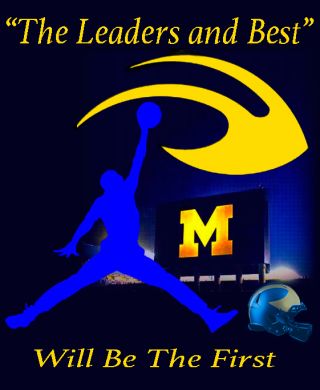Dopamine
America's Infatuation with Jim Harbaugh
What it says about him, our selves, and our brains
Posted August 16, 2015

Why was the media more interested in Jim Harbaugh choosing Michigan over the NFL than Ohio State winning the first college football playoff with a third string quarterback? There are many reasons for this infatuation with Jim Harbaugh. They tell us a lot about him but they reveal much more about who we are.
From Rush Limbaugh to Nicki Minaj – Judge Judy to the U.S. Supreme Court – the word on the street is: Jim Harbaugh rocks. However, it is not because he was a star NFL quarterback, or made Stanford relevant. It’s not even because he coached the 49ers to the NFC championship in his first year, which was supposedly a building season. That just raised his coaching currency. The nation’s love affair with Jim Harbaugh began when the question arose whether he would leave the NFL and return to his alma mater and resurrect Michigan football. This was seen as a long shot, thus making Michigan the underdog. However, people love a long shot and an underdog even more [1] because the chance that the underdog might win against all odds intensifies variable reinforcement. The brain likes variable reinforcement because of the neurochemical rewards.[2-4]
Understanding Variable Reinforcement

To understand variable reinforcement, we must first understand dopamine – the brain’s happy dance drug. The brain uses dopamine to get us to do the necessary things that promote human survival, such as breeding, feeding and social bonding. Hence, the brain releases more dopamine on the anticipation of reward than the reward itself because once we do what it wants us to do – game over. [5-14]
With fixed reinforcement you do 2x and you get 2y – not much anticipation or dopamine in that.[15-17] Conversely, variable reinforcement gives random rewards to specific behaviors – you do 2x and you might get 2y, 0y, or 4y. Variable reinforcement yields lots of dopamine and adrenaline in the anticipation and unpredictability of a big payoff.[2-4, 18-24] Adrenaline is a stimulant. Stimulants are addictive. In terms of neurochemicals, we can think of dopamine as a shot of JD, adrenaline as a blast of cocaine taken immediately after the shot of Jack, and the brain as someone that is not quite back from Woodstock yet. That is why we love an underdog and a long shot (and the longer the better) because underdogs produce larger neurochemical rewards.[25-31] Harbaugh coming to Michigan was a mother lode of variable reinforcement, rich with dopamine and adrenaline for the brain.
When Harbaugh chose Michigan, like any gambler that has won big once, America couldn’t leave the table because we were waiting on the next big payoff.[29, 31-34] Will Harbaugh take Michigan to the National Championship or the Who Cares Bowl? However, it goes beyond variable reinforcement and the story of the prodigal son returning from the big city to save the farm. There is another evolutionary component.

The human brain consolidates and simplifies information. For example, fight-or-flight is the simplifying and consolidating of years of lessons in conflict resolution..[35] Humans are hunters and gatherers. The best things are rare and hard to get, is a consolidation and simplification of years of lessons in hunting and gathering.[36-41] That is why we are drawn to rare things. We equate them with greater value. A heavily sought after NFL coach “going back” to coach college and taking on a difficult task for less money to do a great thing is as rare as it gets, which made Jim Harbaugh even more appealing to our hunter-gatherer instincts. Plus, his behavior epitomizes courage, high moral standards, solid work ethics and virtue.[42][43-50] We are drawn to these traits because evolution and history has taught us that humans would not survive without people who possess these characteristics - more appeal to our basic instincts. [44, 49, 51, 52]
We are also drawn to Harbaugh because we are a social species, and instinctually we know that we are only as strong as our weakest, as healthy as our sickest, as wealthy as our poorest – though we’ve lost sight of that.[53-61] Hence, his many humanitarian deeds add yet another level of subconscious appeal. I asked several top Michigan related Internet social media groups, such as Michigan Football HQ, The University of Michigan M Club, Michigan Proud and True, and Big Ten Talk why they liked Jim Harbaugh. U of M alumnus, Bruce Laing, encapsulates the majority opinion: He will instill toughness and accountability in the athletes, posted Laing in the University of Michigan M Club. Our children's futures are vital, so we embrace the importance of education, accountability and toughness because they galvanize that future; yet another reason America is instinctually drawn to Harbaugh.

In addition, family is the fundamental currency of humanity. Our crumbling family unit is disturbing to the Ventral Tegmental Area (VTA) of the brain, which monitors social connectivity and other vital human needs. [62-74] Jim Harbaugh has strong familial bonds and obviously understands the importance of family. For example, when first arriving at the airport in Detroit, he had his child in his arms as reporters and fans barraged him. However, he was impervious to them and totally focused on making sure his child was safely bundled up. “I think I’ll color this man father,” as the Winstons sang. Witnessing strong father figures causes dopamine release in the VTA region of the brain’s reward circuitry, because such behaviors satisfy vital human needs.[57, 63-65, 72, 75-80]

Finally, in witnessing his persona and values, we are reminded of who we are. For example, after his Alabama camp, he and the Michigan assistant coaches walked across the Edmund Pettus Bridge in Selma, Alabama, the site of the Bloody Sunday Civil Rights Massacre of the 1960's. In listenening to the history and praying with the people, he unintentionally stole the hearts of Black Americans, while reminding all Americans that we are not Europe, Africa, Asia, Canada, Australia, Central or South America – we are all of them. That means we can do anything that is worldly possible, and anticipating that has huge neurochemical benefits: Do 2 million X get 4 billion Y. Back up the dopamine and adrenaline trucks and let her rip. And that is why America loves Jim Harbaugh. He is an inspiring, natural, high - at a time when there are way too many low people in high places pushing quick fixes for ills that can only be healed by persistence, fortitude, family and integrity. Hail! -Remain fabulous and phenomenal!

Or visit me at:
UCLA Center for the Neurobiology of Stress at the David Geffen School of Medicine
REFERENCES
1. Vandello, J.A., N.P. Goldschmied, and D.A. Richards, The appeal of the underdog. Pers Soc Psychol Bull, 2007. 33(12): p. 1603-16.
2. Johansson, A., et al., Risk factors for problematic gambling: a critical literature review. J Gambl Stud, 2009. 25(1): p. 67-92.
3. Eskenazi, D. and J.F. Neumaier, Increased expression of 5-HT(6) receptors in dorsolateral striatum decreases habitual lever pressing, but does not affect learning acquisition of simple operant tasks in rats. Eur J Neurosci, 2011. 34(2): p. 343-51.
4. Brody, A.L., et al., Gene variants of brain dopamine pathways and smoking-induced dopamine release in the ventral caudate/nucleus accumbens. Arch Gen Psychiatry, 2006. 63(7): p. 808-16.
5. Jones, S. and A. Bonci, Synaptic plasticity and drug addiction. Curr Opin Pharmacol, 2005. 5(1): p. 20-5.
6. Ikemoto, S., The supramammillary nucleus mediates primary reinforcement via GABA(A) receptors. Neuropsychopharmacology, 2005. 30(6): p. 1088-95.
7. Frank, G.K., et al., Sucrose activates human taste pathways differently from artificial sweetener. Neuroimage, 2008. 39(4): p. 1559-69.
8. Snyder, M. and L. Platt, Substance use and brain reward mechanisms in older adults. J Psychosoc Nurs Ment Health Serv, 2013. 51(7): p. 15-20.
9. Lahera, G., N. Freund, and J. Saiz-Ruiz, Salience and dysregulation of the dopaminergic system. Rev Psiquiatr Salud Ment, 2013. 6(1): p. 45-51.
10. Gao, J., et al., Roles of dopaminergic innervation of nucleus accumbens shell and dorsolateral caudate-putamen in cue-induced morphine seeking after prolonged abstinence and the underlying D1- and D2-like receptor mechanisms in rats. J Psychopharmacol, 2013. 27(2): p. 181-91.
11. Volkow, N.D., et al., Role of dopamine, the frontal cortex and memory circuits in drug addiction: insight from imaging studies. Neurobiol Learn Mem, 2002. 78(3): p. 610-24.
12. Hernandez, G., et al., Role of dopamine tone in the pursuit of brain stimulation reward. J Neurosci, 2012. 32(32): p. 11032-41.
13. Haber, S.N., et al., Reward-related cortical inputs define a large striatal region in primates that interface with associative cortical connections, providing a substrate for incentive-based learning. J Neurosci, 2006. 26(32): p. 8368-76.
14. Cohen, J.D. and K.I. Blum, Reward and decision. Neuron, 2002. 36(2): p. 193-8.
15. Shoaib, M. and R. Spanagel, Mesolimbic sites mediate the discriminative stimulus effects of morphine. Eur J Pharmacol, 1994. 252(1): p. 69-75.
16. Oler, J.A., et al., Hippocampal and amygdalar involvement in discriminatory place learning. Neuroscience, 2005. 132(1): p. 1-12.
17. Smith, K.S., K.C. Berridge, and J.W. Aldridge, Disentangling pleasure from incentive salience and learning signals in brain reward circuitry. Proc Natl Acad Sci U S A, 2011. 108(27): p. E255-64.
18. Dehaene, S. and J.P. Changeux, Reward-dependent learning in neuronal networks for planning and decision making. Prog Brain Res, 2000. 126: p. 217-29.
19. Cheung, T.H., et al., Reduction of cocaine self-administration and D3 receptor-mediated behavior by two novel dopamine D3 receptor-selective partial agonists, OS-3-106 and WW-III-55. J Pharmacol Exp Ther, 2013. 347(2): p. 410-23.
20. Kai, N., Y. Tsutsui, and K. Kobayashi, Lesions of the nucleus accumbens core modulate development of matching behavior. BMC Neurosci, 2014. 15: p. 55.
21. Corwin, R.L., N.M. Avena, and M.M. Boggiano, Feeding and reward: perspectives from three rat models of binge eating. Physiol Behav, 2011. 104(1): p. 87-97.
22. Gallistel, C.R., Extinction from a rationalist perspective. Behav Processes, 2012. 90(1): p. 66-80.
23. Rogers, R.D., et al., The effects of low doses of delta-9 tetrahydrocannabinol on reinforcement processing in the risky decision-making of young healthy adults. Neuropsychopharmacology, 2007. 32(2): p. 417-28.
24. Pribram, K.H. and D. McGuinness, Attention and para-attentional processing. Event-related brain potentials as tests of a model. Ann N Y Acad Sci, 1992. 658: p. 65-92.
25. Adriani, W., et al., Social withdrawal and gambling-like profile after lentiviral manipulation of DAT expression in the rat accumbens. Int J Neuropsychopharmacol, 2010. 13(10): p. 1329-42.
26. Comings, D.E. and K. Blum, Reward deficiency syndrome: genetic aspects of behavioral disorders. Prog Brain Res, 2000. 126: p. 325-41.
27. Shinohara, K., et al., Physiological changes in Pachinko players; beta-endorphin, catecholamines, immune system substances and heart rate. Appl Human Sci, 1999. 18(2): p. 37-42.
28. Meyer, G., et al., Neuroendocrine response to casino gambling in problem gamblers. Psychoneuroendocrinology, 2004. 29(10): p. 1272-80.
29. Brewer, J.A. and M.N. Potenza, The neurobiology and genetics of impulse control disorders: relationships to drug addictions. Biochem Pharmacol, 2008. 75(1): p. 63-75.
30. Chau, D.T., R.M. Roth, and A.I. Green, The neural circuitry of reward and its relevance to psychiatric disorders. Curr Psychiatry Rep, 2004. 6(5): p. 391-9.
31. Clark, L. and E.H. Limbrick-Oldfield, Disordered gambling: a behavioral addiction. Curr Opin Neurobiol, 2013. 23(4): p. 655-9.
32. de Ruiter, M.B., et al., Response perseveration and ventral prefrontal sensitivity to reward and punishment in male problem gamblers and smokers. Neuropsychopharmacology, 2009. 34(4): p. 1027-38.
33. Clark, L., et al., Pathological choice: the neuroscience of gambling and gambling addiction. J Neurosci, 2013. 33(45): p. 17617-23.
34. Goudriaan, A.E., M. Yucel, and R.J. van Holst, Getting a grip on problem gambling: what can neuroscience tell us? Front Behav Neurosci, 2014. 8: p. 141.
35. McEwen, B., Lasley, E, End of Stress as we know it. 2002, Washington, D.C.: Joseph Henry Press.
36. Nairne, J.S., et al., Adaptive memory: fitness relevance and the hunter-gatherer mind. Psychol Sci, 2009. 20(6): p. 740-6.
37. Haak, W., et al., Ancient DNA from European early neolithic farmers reveals their near eastern affinities. PLoS Biol, 2010. 8(11): p. e1000536.
38. Wynn, T., Archaeology and cognitive evolution. Behav Brain Sci, 2002. 25(3): p. 389-402; discussion 403-38.
39. Lasker, G.W. and D.E. Crews, Behavioral influences on the evolution of human genetic diversity. Mol Phylogenet Evol, 1996. 5(1): p. 232-40.
40. Baars, B.J. and D.B. Edelman, Consciousness, biology and quantum hypotheses. Phys Life Rev, 2012. 9(3): p. 285-94.
41. Katz, M.C., Hunting and gathering information. Conn Med, 2013. 77(6): p. 375-6.
42. Camps, V., [Neurons and values]. Rev Neurol, 2013. 57(5): p. 230-4.
43. Wolff, S., Attachment and morality: developmental themes with different values. Br J Psychiatry, 1990. 156: p. 266-71.
44. Leyhausen, P., The biological basis of ethics and morality. Sci Med Man, 1974. 1(4): p. 215-35.
45. Fumagalli, M. and A. Priori, Functional and clinical neuroanatomy of morality. Brain, 2012. 135(Pt 7): p. 2006-21.
46. Funk, C.M. and M.S. Gazzaniga, The functional brain architecture of human morality. Curr Opin Neurobiol, 2009. 19(6): p. 678-81.
47. Sobel, R.K., Mind in a mirror. Mapping morality, awareness, and 'self' in the brain. US News World Rep, 2001. 131(20): p. 64-5.
48. Moll, J., R. De Oliveira-Souza, and R. Zahn, The neural basis of moral cognition: sentiments, concepts, and values. Ann N Y Acad Sci, 2008. 1124: p. 161-80.
49. Alvaro-Gonzalez, L.C., [Neuroethics (I): moral pathways in normal brain]. Rev Neurol, 2014. 58(5): p. 225-33.
50. Bzdok, D., et al., Parsing the neural correlates of moral cognition: ALE meta-analysis on morality, theory of mind, and empathy. Brain Struct Funct, 2012. 217(4): p. 783-96.
51. Azzone, G.F., The dual biological identity of human beings and the naturalization of morality. Hist Philos Life Sci, 2003. 25(2): p. 211-41.
52. Doty, R.W., The five mysteries of the mind, and their consequences. Neuropsychologia, 1998. 36(10): p. 1069-76.
53. Costantini, M. and F. Ferri, Action co-representation and social exclusion. Exp Brain Res, 2013. 227(1): p. 85-92.
54. McEwen, B.S., Allostasis and allostatic load: implications for neuropsychopharmacology. Neuropsychopharmacology, 2000. 22(2): p. 108-24.
55. Skuse, D., J. Morris, and K. Lawrence, The amygdala and development of the social brain. Ann N Y Acad Sci, 2003. 1008: p. 91-101.
56. Young, L.J., A.Z. Murphy Young, and E.A. Hammock, Anatomy and neurochemistry of the pair bond. J Comp Neurol, 2005. 493(1): p. 51-7.
57. Pedersen, C.A., Biological aspects of social bonding and the roots of human violence. Ann N Y Acad Sci, 2004. 1036: p. 106-27.
58. Berns, G.S. and S. Atran, The biology of cultural conflict. Philos Trans R Soc Lond B Biol Sci, 2012. 367(1589): p. 633-9.
59. Kedia, G., et al., Brain networks of social comparison. Neuroreport, 2013. 24(5): p. 259-64.
60. Smith, D.D., Brain, environment, heredity, and personality. Psychol Rep, 1993. 72(1): p. 3-13.
61. Reid, A.H. and H.E. Kirk, Brain, mind and behaviour. Br J Psychiatry, 1994. 164(5): p. 708-9.
62. Gardner, E.L., Addictive potential of cannabinoids: the underlying neurobiology. Chem Phys Lipids, 2002. 121(1-2): p. 267-90.
63. Joffe, M.E., C.A. Grueter, and B.A. Grueter, Biological substrates of addiction. Wiley Interdiscip Rev Cogn Sci, 2014. 5(2): p. 151-171.
64. Wise, R.A. and P.P. Rompre, Brain dopamine and reward. Annu Rev Psychol, 1989. 40: p. 191-225.
65. Ikemoto, S., Brain reward circuitry beyond the mesolimbic dopamine system: a neurobiological theory. Neurosci Biobehav Rev, 2010. 35(2): p. 129-50.
66. Wise, R.A. and M.A. Bozarth, Brain reward circuitry: four circuit elements "wired" in apparent series. Brain Res Bull, 1984. 12(2): p. 203-8.
67. Sesack, S.R. and A.A. Grace, Cortico-Basal Ganglia reward network: microcircuitry. Neuropsychopharmacology, 2010. 35(1): p. 27-47.
68. Northoff, G. and D.J. Hayes, Is our self nothing but reward? Biol Psychiatry, 2011. 69(11): p. 1019-25.
69. Bossert, J.M., et al., A role of ventral tegmental area glutamate in contextual cue-induced relapse to heroin seeking. J Neurosci, 2004. 24(47): p. 10726-30.
70. Briand, L.A., et al., Ventral tegmental afferents in stress-induced reinstatement: the role of cAMP response element-binding protein. J Neurosci, 2010. 30(48): p. 16149-59.
71. Vargas-Perez, H., et al., Ventral tegmental area BDNF induces an opiate-dependent-like reward state in naive rats. Science, 2009. 324(5935): p. 1732-4.
72. Ting, A.K.R., et al., Ventral tegmental area GABA neurons and opiate motivation. Psychopharmacology (Berl), 2013. 227(4): p. 697-709.
73. Noel, M.B. and R.A. Wise, Ventral tegmental injections of morphine but not U-50,488H enhance feeding in food-deprived rats. Brain Res, 1993. 632(1-2): p. 68-73.
74. Britt, M.D. and R.A. Wise, Ventral tegmental site of opiate reward: antagonism by a hydrophilic opiate receptor blocker. Brain Res, 1983. 258(1): p. 105-8.
75. Nestler, E.J. and W.A. Carlezon, Jr., The mesolimbic dopamine reward circuit in depression. Biol Psychiatry, 2006. 59(12): p. 1151-9.
76. Ting, A.K.R. and D. van der Kooy, The neurobiology of opiate motivation. Cold Spring Harb Perspect Med, 2012. 2(10).
77. Glimcher, P.W., et al., Neurotensin: a new 'reward peptide'. Brain Res, 1984. 291(1): p. 119-24.
78. Ouachikh, O., et al., Anterior ventral tegmental area dopaminergic neurons are not involved in the motivational effects of bromocriptine, pramipexole and cocaine in drug-free rats. Behav Brain Res, 2014. 262: p. 1-7.
79. Phillips, A.G., Brain reward circuitry: a case for separate systems. Brain Res Bull, 1984. 12(2): p. 195-201.
80. Wise, R.A., Brain reward circuitry: insights from unsensed incentives. Neuron, 2002. 36(2): p. 229-40.




